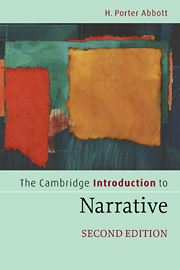Book contents
- Frontmatter
- Contents
- List of illustrations
- Preface
- Preface to the second edition
- Acknowledgments
- Chapter 1 Narrative and life
- Chapter 2 Defining narrative
- Chapter 3 The borders of narrative
- Chapter 4 The rhetoric of narrative
- Chapter 5 Closure
- Chapter 6 Narration
- Chapter 7 Interpreting narrative
- Chapter 8 Three ways to interpret narrative
- Chapter 9 Adaptation across media
- Chapter 10 Character and self in narrative
- Chapter 11 Narrative and truth
- Chapter 12 Narrative worlds
- Chapter 13 Narrative contestation
- Chapter 14 Narrative negotiation
- Notes
- Bibliography
- Glossary and topical index
- Index of authors and narratives
Chapter 1 - Narrative and life
- Frontmatter
- Contents
- List of illustrations
- Preface
- Preface to the second edition
- Acknowledgments
- Chapter 1 Narrative and life
- Chapter 2 Defining narrative
- Chapter 3 The borders of narrative
- Chapter 4 The rhetoric of narrative
- Chapter 5 Closure
- Chapter 6 Narration
- Chapter 7 Interpreting narrative
- Chapter 8 Three ways to interpret narrative
- Chapter 9 Adaptation across media
- Chapter 10 Character and self in narrative
- Chapter 11 Narrative and truth
- Chapter 12 Narrative worlds
- Chapter 13 Narrative contestation
- Chapter 14 Narrative negotiation
- Notes
- Bibliography
- Glossary and topical index
- Index of authors and narratives
Summary
The universality of narrative
When we think of narrative, we usually think of it as art, however modest. We think of it as novels or sagas or folk tales or, at the least, as anecdotes. We speak of a gift for telling stories. But as true as it is that narrative can be an art and that art thrives on narrative, narrative is also something we all engage in, artists and non-artists alike. We make narratives many times a day, every day of our lives. And we start doing so almost from the moment we begin putting words together. As soon as we follow a subject with a verb, there is a good chance we are engaged in narrative discourse. “I fell down,” the child cries, and in the process tells her mother a little narrative, just as I have told in this still unfinished sentence a different, somewhat longer narrative that includes the action of the child's telling (“‘I fell down,’ the child cries”).
Given the presence of narrative in almost all human discourse, there is little wonder that there are theorists who place it next to language itself as the distinctive human trait. Fredric Jameson, for example, writes about the “all-informing process of narrative,” which he describes as “the central function or instance of the human mind.” Jean-François Lyotard calls narration “the quintessential form of customary knowledge.”
- Type
- Chapter
- Information
- The Cambridge Introduction to Narrative , pp. 1 - 12Publisher: Cambridge University PressPrint publication year: 2008
- 1
- Cited by

